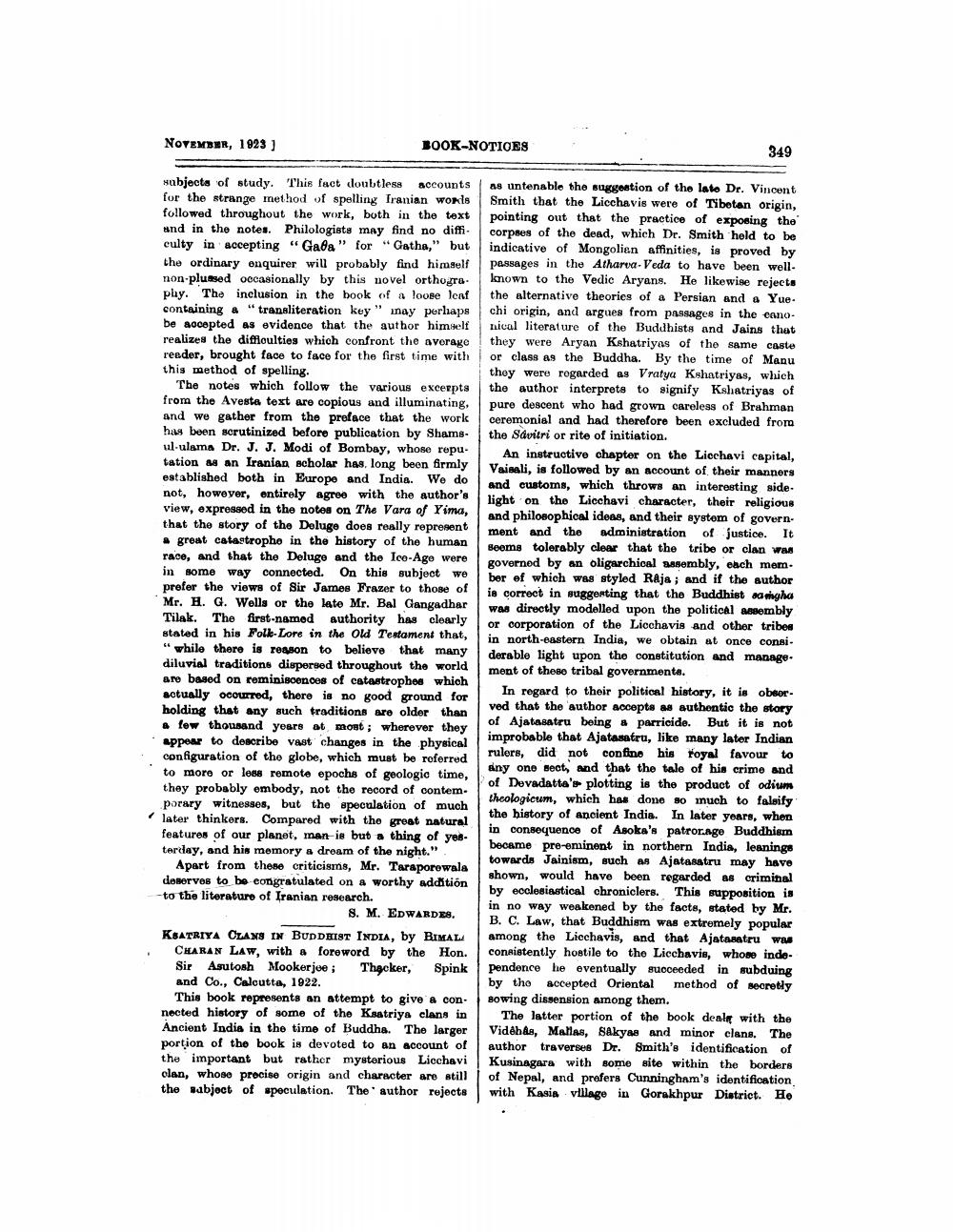________________
NOVEMBER, 1923)
BOOK-NOTICES
349
Habjects of study. This fact doubtless accounts as untenable the suggestion of the lato Dr. Vincent for the strange method of spelling Iranian words Smith that the Licchavis were of Tibetan origin, followed throughout the work, both in the text pointing out that the practice of exposing the and in the notes. Philologists may find no diffi. corpaes of the dead, which Dr. Smith held to be culty in accepting “Gada" for "Gatha," but indicative of Mongolien affinities, is proved by the ordinary onquirer will probably find himself passages in the Atharva-Veda to have been wellnon-plussed occasionally by this novel orthogra. known to the Vedic Aryans. He likewise rejects play. The inclusion in the book of a loose leaf the alternative theories of a Persian and a Yue. containing a "transliteration key” inay perhaps chi origin, and argues from passages in the eanobe accepted as evidence that the author himself nical literature of the Buddhists and Jains that realizes the diffioulties which confront the average ! they were Aryan Kshatriyas of the same caste reader, brought face to face for the first time with or class as the Buddha. By the time of Manu this method of spelling.
thoy were regarded as Vratya Kshatriyas, which The notes which follow the various excerpts the author interprets to signify Kshatriyas of from the Avesta text are copious and illuminating, pure descent who had grown careless of Brahman and we gather from the preface that the work ceremonial and had therefore been excluded from has been scrutinized before publication by Shams- the Savitri or rite of initiation. ul-ulama Dr. J. J. Modi of Bombay, whose repu
An instructive chapter on the Liechavi capital, tation Man Iranian scholar has long been firmly
Vainali, is followed by an account of their manners established both in Europe and India. Wo do
and customs, which throws an interesting side. not, however, entirely agree with the author's
light on the Licchavi character, their religious view, expressed in the notes on The Vara of Yima,
and philosophical ideas, and their system of govern that the story of the Doluge does really represent
ment and the administration of justice. It great catastrophe in the history of the human
seems tolerably clear that the tribe or clan was race, and that the Deluge and the Ice-Age were
governed by an oligarchical sasembly, each mem. in some way connected. On this subject we
ber of which was styled R&ja; and if the author prefer the views of Sir James Frazer to those of
is correct in suggesting that the Buddhist sangha Mr. H. G. Wells or the late Mr. Bal Gangadhar
was directly modelled upon the political assembly Tilak. The first-named authority has clearly
or corporation of the Licchavis and other tribes stated in his Folk-Lore in the Old Testament that,
in north-eastern India, we obtain at once consi" while there is reason to believe that many derable light upon the constitution and managediluvial traditions dispersed throughout the world
ment of these tribal governments. are based on reminiscences of catastrophee which
In regard to their political history, it is obsoractually ocorred, there is no good ground for holding that any such traditions are older than
ved that the author accepts as authontác the story & few thousand years at most; wherever they
of Ajatasatru being a parricide. But it is not
improbable that Ajatasatru, like many later Indian appear to describe vast changes in the physical
rulers, did not confine his royal favour to configuration of the globe, which must be roferred
any one sect, and that the tale of his crime and to more or less remote epochs of geologic time,
of Dovadatta's plotting is the product of odium they probably embody, not the record of contem
theologicum, which has done so much to falsify porary witnesses, but the speculation of much
the history of Ancient India. In later years, when later thinkers. Compared with the great natural
in consequence of Asoka's patror.age Buddhism features of our planet, man-is but a thing of yes.
became pre-eminent in northern India, leanings terday, and his memory a dream of the night." Apart from these criticisms, Mr. Taraporewala
towards Jainism, such as Ajataastru may have
shown, would have been regarded as criminal deserves to be congratulated on a worthy addition
by ecclesiastical chroniclers. This supposition is to the literature of Iranian research.
in no way weakened by the facts, stated by Mr. 8. M. EDWARDES.
B. C. Law, that Buddhism was extremely popular KSATRIYA OLANS IN BUDDHIST INDIA, by BIMAL among the Licchavis, and that Ajatasatru wa
CHARAN LAW, with a foreword by the Hon. consistently hostile to the Licchavis, whose indeSir Asutosh Mookerjee; Thacker, Spink pendence he eventually succeeded in subduing and Co., Calcutta, 1922.
by tho accepted Oriental method of secretly This book represents an attempt to give a con Bowing dissension among them. nected history of some of the Ksatriya clans in The latter portion of the book dealt with the Ancient India in the time of Buddha. The larger Videh As, Mallas, Sakyae and minor clans. The portion of the book is devoted to an account of author traverses Dr. Smith's identification of the important but rather mysterious Licchavi Kusinagara with some site within the borders olan, whose precise origin and character are still of Nepal, and prefers Cunningham's identification the sabjoct of speculation. The author rejects with Kasia village in Gorakhpur District. He




